CGI Boobs: 7 Special Effects The Stars Want to Keep Secret
If you gave any one of our big tech industries millions of dollars, a team of computer geniuses and cutting edge technology, they would probably waste it on AIDS vaccine research or nanocomputers or something. Hollywood will invest it in CG penis enhancement.
The reason is sometimes hours of makeup and the perfect lighting still aren't enough to make some stars look like stars. Welcome to the world of "vanity visual effects."
Angelina Jolie's Naked Body in Beowulf (2007)
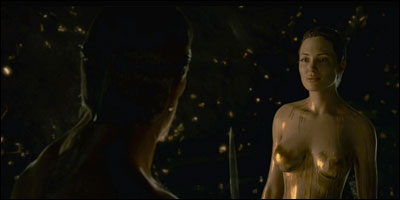
Beowulf continued the proud tradition of "performance capture" earlier exhibited in Polar Express, where real actors' bodies and motions are painstakingly captured and digitized into the computer world to play terrifying dead-eyed zombies (it is believed eye performances were captured separately, from that cupcake dog.)

In Beowulf, Angelina Jolie plays a nude lizard woman. In an interview, Jolie speaks about how shy she was about having her naked body scanned for the part, which is odd considering that the body you saw in the film came from Rachel Bernstein, who "has made a living winning swimsuit competitions" while "appearing in almost every lingerie catalog in LA."
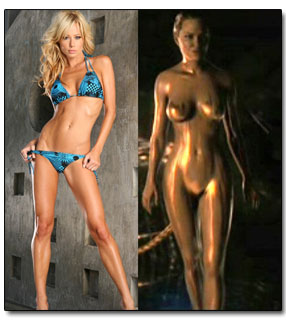
That resume certainly qualifies her for the role, but leaves a few questions unanswered. Angelina Jolie, by all appearances, has a perfectly fine body, and any worrisome changes due to her three-month pregnancy at the time could have easily been touched up as they freely admitted to doing with the male actors.

"Ugh, she is hideous. Hire a body double, I'm gonna puke."
It might just be a symptom of society's double standards that actors can freely brag about getting better fake bodies while actresses have to keep up a pretense of being physically perfect. Or maybe she honestly didn't know. It certainly seems possible that when Angelina Jolie asked if they needed her to disrobe to have every square inch of her naked boobs scanned into a computer, some unscrupulous devil at the Sony scanning lab conveniently forgot to mention the body double.
Kevin Costner's Hairline (and Neck Vaginas) in Waterworld (1995)

Waterworld holds a special place in entertainment history as one of the easiest punchlines of all time. When produced in 1995, for a budget of $175 million, it was the most expensive film ever made; money clearly well-spent on CG representations of things you can't find in real life, like the ocean. It turned out that, in addition to the planned out effects, after shooting had wrapped, some unfortunate observations came to light, such as the fact that Kevin Costner was losing his hair.

Costner in 1995. According to our Photoshop Department.
At this point, Costner realized that audiences would never be able to take his role as a half-fish/half-man seriously if they kept being distracted by his male-pattern baldness. Costner reportedly asked for reshoots and CG fixes, leading to one of many arguments that eventually got director Kevin Reynolds kicked off the movie.
Costner may have been inspired by another aging action hero. In 1991, it was rumored that Bruce Willis ordered his thinning hair touched up in Hudson Hawk which, if true, would have been even more ridiculous, budget-wise, as photorealistic CG wasn't available in 1991, and the hair would have had to be pretty much hand-painted frame-by-frame by a 2D artist. It seems like Costner may have taken the wrong lesson away from this cautionary tale of vanity (The biggest flop of the 90s prior to Waterworld? Hudson Hawk).

More understandable was some after-the-fact CG gill modification. Costner, as a fish-man in the movie, had gills on his neck. Above water they looked like gills, while underwater, as it turns out, they looked like vaginas. Needless to say, additional budget was found for some quick digital fixes. While they had saved themselves from losing the "family" audience, sales in Japan would suffer.
Vivien Leigh's Eye Color in Gone With The Wind (1939)

It's easy to think that vanity visual effects started with the introduction of CGI to movies, but phoniness and gratuitous image manipulation have always been an integral part of Hollywood movie making, as the urge for this kind of arbitrary after-the-fact tinkering transcends technological limitations.

Like when they digitally added Jabba the Hutt into Citizen Kane.
In 1936, when it came time to cast an actress for the green-eyed Scarlett O'Hara in Gone With The Wind, producer David Selznick went through an enormous two-year talent search looking at all the top actresses of the day. The final choice for the green-eyed Southern belle was a blue-eyed English actress named Vivien Leigh.
As production kicked into gear, in 1939, it suddenly occurred to Selznick that films were now in color. Technicolor had only introduced its groundbreaking three-color process for live action films in 1934, five years before, so Selznick could be forgiven for letting it slip his mind.
Rather than entertain the thought that the eye color of the main character may not be the most important aspect of a movie, Selznick pressured Monty Westmore, the makeup artist, to cover his ass on this one. He would call Westmore repeatedly at three in the morning and other odd hours, to explain that Vivien Leigh's eyes were still not green. Fans of the book would apparently settle for nothing less.

On the left you can see Vivien Leigh with green eyes as seen in Gone With The Wind, and blue eyes have been added on the right so that- oh seriously, who even cares?
Rather than wait decades for the introduction of colored contact lenses, the unfortunate Westmore, the cinematographer and the costume designer struggled to do their jobs using a combination of lens filters, reflective green costumes and enough green eyeshadow to drown a grown man.
Nicolas Cage's Abs in Ghost Rider (2007)

Nicolas Cage has always been a little like a mild version of post-steroid Carrot Top--someone whose head doesn't seem to belong with his body.
Since at least Con Air, Cage has put a lot of work into his body, with fairly impressive results. Meanwhile, his head continues to look like Nicolas Cage's head, and his hairline in particular seems to take a step back for every ounce of muscle he gains.

This discrepancy is probably what has fueled accusations of CG muscle fakery against Cage from time to time, much of it likely to be unfounded. His action hero role in Ghost Rider once again calls for a handsome, ripped young man, but Cage was cast instead, and he did his best. He's talked about the amount of work put into getting in shape for the film and photos of him on the set seem to show the results:
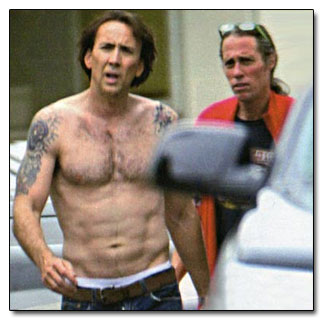
So you'd think no CG help would be needed. However, some after-the-fact tattoo removal had to be done, and it seems that while they were in there, they couldn't help but fix a few other things here and there:

And now it's just silly. Why bother with a trainer at all, when they're just going to use the body of a Rambo action figure instead.
Jennifer Connelly's Tear in Blood Diamond (2006)

Suppose that you have a crucial emotional shot of Jennifer Connelly looking distressed while talking on a mobile phone. You were happy with her performance at the time, but in the context of the film, you realize she needs to take it to a whole new level of distress. If you were George Lucas or the lady that wrote Twilight, the solution would be pretty simple: you would just dub in a line where Jennifer Connelly states, "I am distressed! Very, very distressed!" Meanwhile, directors capable of understanding human emotions might dial that back a few notches and simply add a digital tear rolling down her cheek.

That's only the tip of the iceberg as far as performance alterations. As the linked article mentions, "Visual effects experts privately admit to changing actors' expressions: opening or closing eyes; making a limp more convincing; removing breathing signs; eradicating blinking eyelids from a lingering gaze; or splicing together different takes of an unsuccessful love scene to produce one in which both parties look like they are enjoying themselves."
In the future, if technology advances far enough, we could see a visual effects equivalent of the Auto-Tune, software that could add any emotion to any actor, possibly spelling the end of ironically enjoying Keanu Reeves performances, which would be a shame.
Brandon Routh's "Bulge" in Superman Returns (2006)
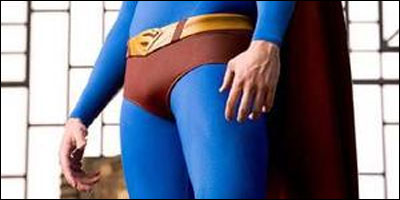
Superman's main features were always supposed to be his chiseled face, his spit-curl and the big S symbol on his chest, and not his genitals. During production of the Superman Returns movie, Brandon Routh's mighty package allegedly became a distraction.
Shape and size became vital issues within the costume department, and digital effects were considered to reduce the size of the package in post-production. After a great deal of discreet work, children everywhere were saved from learning that men and women are different. And that some men are way different.

There is no indication of what "inside source" originally leaked the "Superman's dong is just too huge" rumor, but in our minds we picture a shadowy, Brandon Routh-shaped informant.
On the side of equal opportunity, Lindsay Lohan's breast size was allegedly reduced in Herbie: Fully Loaded, preserving one audience segment while alienating another. Lending credence to that rumor is the fact that Lola VFX, a well-known digital cosmetic enhancement shop, worked on the film.

Booooo.
Music videos are also a lucrative area for post-production fixes, one of the most unfortunate being adding digital panties to Carmen Electra in a Li'l Kim video after an unintentional flash.
Kevin Bacon's Penis in Hollow Man (2000)

On the complete opposite end of the spectrum from the family-friendly modifications in Superman Returns and Herbie, we have Paul Verhoeven's Hollow Man, based on the classic H.G. Wells novel The Invisible Rapist. It attempts to answer the age-old question: What would you do if you were a huge jerk that was able to become invisible? It's an important philosophical question that apparently can't be answered without showing penis. Like, a lot.
Kevin Bacon gets to showcase his manhood in possibly more ways than any other film has ever showcased a wiener. Whether it be plain old nudity, or heat vision swinging dong...
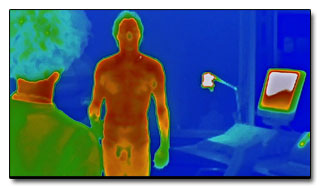
... or skinless man dong...

... or underwater dong...

... or shaking-off-water dong...

... or dong passing through smoke.

Now, the dong passing through smoke is barely visible, but it's important to take note of, because Verhoeven very specifically instructed artists to ensure it was visible. It was vital to him that Kevin Bacon's invisible penis be apparent in as many shots as possible.
While the heat vision shot only involved taking regular footage of Kevin Bacon walking around naked and running it through a filter, the water shots and the smoke shots specifically required an entire CG Kevin Bacon to be built, with CG joints and controls on every part of the body, including the penis, all controllable by animators, allowing them to increase penis swing on the smoke shot, for example, if necessary. And Verhoeven felt it was necessary.

Rumors also indicate that Kevin Bacon himself, after viewing some of the shots, discreetly requested some modifications using the universal language of dong description: he nodded toward the dong, held his hands some distance apart and then increased the distance.
We can laugh, but what man reading this wouldn't have done the exact same thing?
And check out some movies where a little CG was desperately needed, in The 5 Most Half-Assed Monsters in Movie History. Or find out about Hollywood is using more than just CGI to rip you off, in 5 Innovative Ways Hollywood Is Screwing You Over.
And head over to Cracked.com's Top Picks to see evidence that we don't need CG effects to enhance our dongs.





